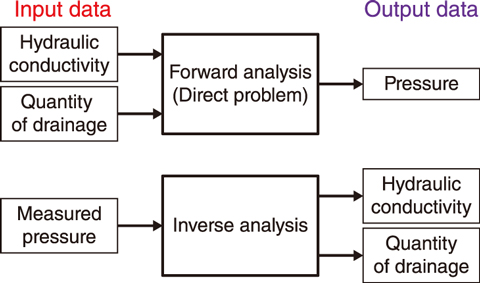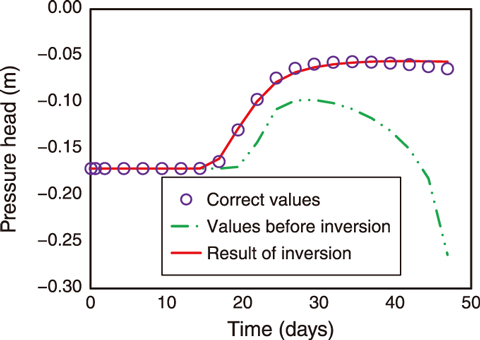
Fig.8-11 Multi-layered earthen cover

Fig.8-12 Analysis flow

Fig.8-13 Result of inverse analysis
In an effort to reduce the environmental burden of uranium mines, earthen covers have been installed on the mine tailings shown in Figs.8-11(a) and (b) to reduce the generated wastewater caused by rainwater contacting the mine tailings. Groundwater flow simulations have been used evaluate the impact of these covers. However, the forward analysis method used in such models have often provided results that do not match the measured values at the site, likely due to the heterogeneity of soil properties caused by construction and to the measurement error of the drainage flow on the side. Model calibration is often carried out by trial and error to help remedy this problem. Unfortunately, this method increases thus subjectivity; as such, a more objective input parameter setting method is required. In another method, shown in Fig.8-12, the hydraulic conductivity and quantity of drainage flow can be simultaneously estimated by using a known water pressure distribution. This process, known as inverse analysis, leads to more efficient calibration. Furthermore, we used the adjoint state method with the quasi-Newton method to perform high-speed calculations. Therefore, this work proposes the application of inverse analysis by the adjoint state method with the quasi-Newton method on a saturated-unsaturated flow in such a field.
A numerical analysis using inverse analysis was carried out. To evaluate the effectiveness of the inverse analysis method, the following experiment was designed. First, the water pressure distribution was calculated by forward analysis and labeled as the correct value. An inverse analysis based on the correct values was then performed to estimate the hydraulic distribution and drainage quantity; the results, shown in Fig.8-13, indicate that the correct values could be expressed appropriately with forward analysis using the estimation result by inverse analysis. Thus, uncertain parameters can be estimated by simultaneous inverse analysis. Using this method allows the necessary input parameters for forward analysis to be obtained, which may lead to an improved understanding of groundwater flow. Furthermore, applying this method to earthen covers will allow researchers to evaluate the effects of rainwater infiltration, thus contributing to the development of a rational and effective earthen cover.